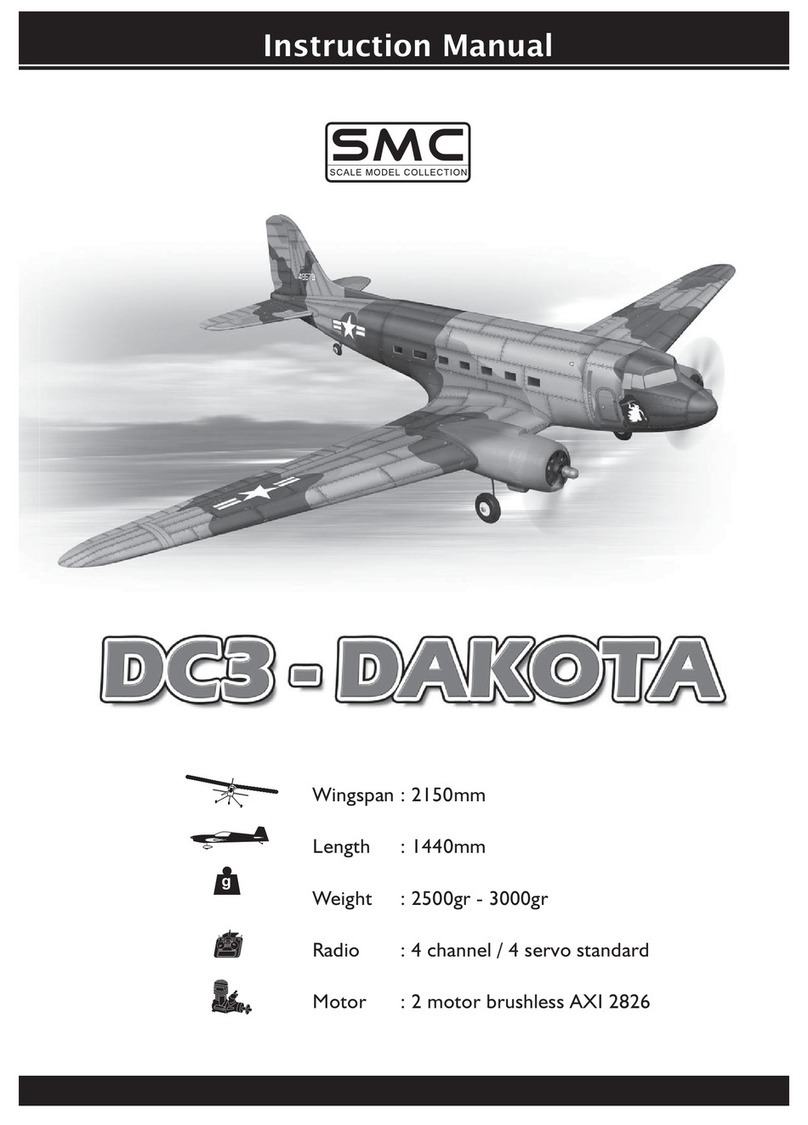2. Locate one nylon servo arm, and using wire
cutters, remove all but one of the arms. Using a
2mm drill bit, enlarge the third hole out from the
center of the arm to accommodate the aileron
pushrod wire.
3. Plug the aileron servo into the receiver and
center the servo. Install the servo arm onto the
servo. The servo arm should be perpendicular to
the servo and point toward the middle of the wing.
4. Center the aileron and hold it in place using a
couple of pieces of masking tape.
5. With the aileron and aileron servo centered,
carefully place a mark on the aileron pushrod
wire where it crosses the hole in the servo arm.
6. Using pliers, carefully make a 90 degree bend
down at the mark made. Cut off the excess
wire, leaving about 4mm beyond the bend.
8. Repeat step # 1 - # 7 to install the second
aileron linkage. After both linkages are completed,
connect both of the aileron servo leads using a
Y-harness you have purchased separately.
JOINING THE WING HALVES
1. Mix a generous amount of 30 minute epoxy.
Working with only one wing half for now, apply
a thin layer of epoxy inside the carton tube and
to only half of the dihedral brace. Make sure to
cover the dihedral brace top and bottom as well
as the sides, and use enough epoxy to fill any
gaps.
2. Slide the dihedral brace into the carton tube up
to the center line. Remove any excess epoxy
before it dries using a paper towel and rubbing
alcohol. Allow the epoxy to cure before
proceeding.
3. Once the epoxy has cured, trial fit both wing
halves together to double check that the wing
halves still fit correctly.
4. Mix a generous amount of 30 minute epoxy.
Apply a thin layer of epoxy to the exposed half
of the dihedral brace, the inside of the carton
tube and the entire surface of both root ribs.
Make sure to use enough epoxy to fill any
gaps.
5. Slide the two wing halves together and carefully
align them at the leading and trailing edges.
Wipe away any excess epoxy using a paper
towel and rubbing alcohol. Use masking tape to
hold the two wing halves in place until the
epoxy cures.
14
5
CORSAIR F4U
Instruction Manual
15
12
13
6. When the epoxy has fully cured, double check
the center section joint. If any gaps are present,
mix a small amount of 30 minute epoxy and
carefully fill any remaining gaps. Remove the
excess epoxy using a paper towel and rubbing
alcohol. Allow the epoxy to fully cure before
proceeding.
7. Apply the trim tape to the center section of the
wings where they join.
7. Insert the 90 degree bend down through the
hole in the servo arm. Install one nylon snap
keeper over the wire to secure it to the arm.
Install the servo arm retaining screw and
remove the masking tape from the aileron.




























